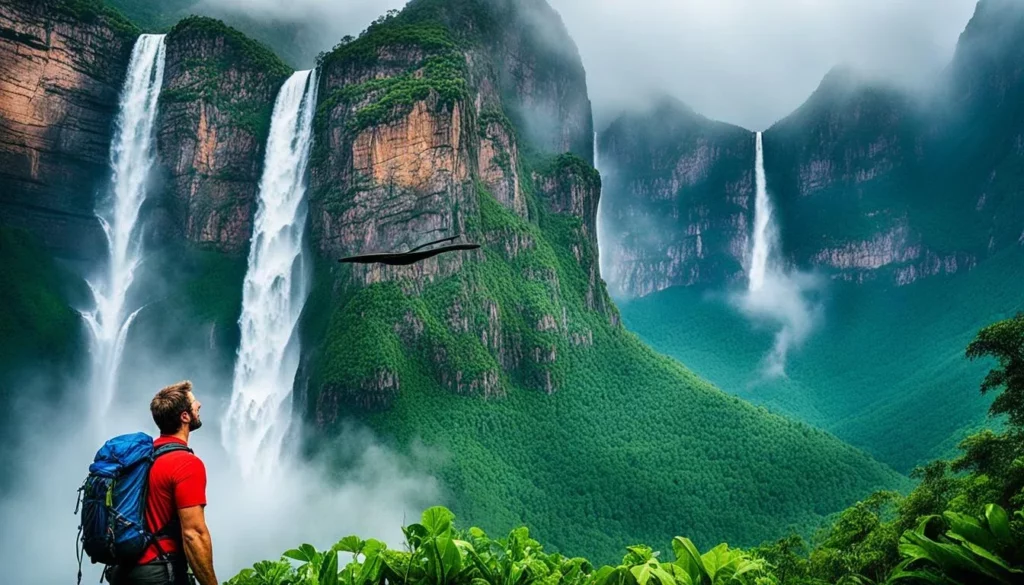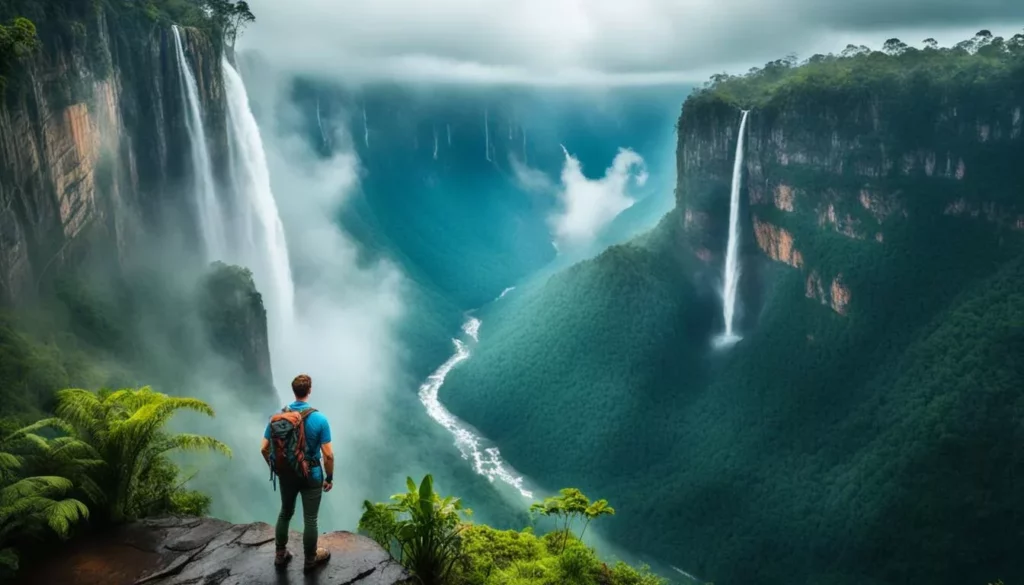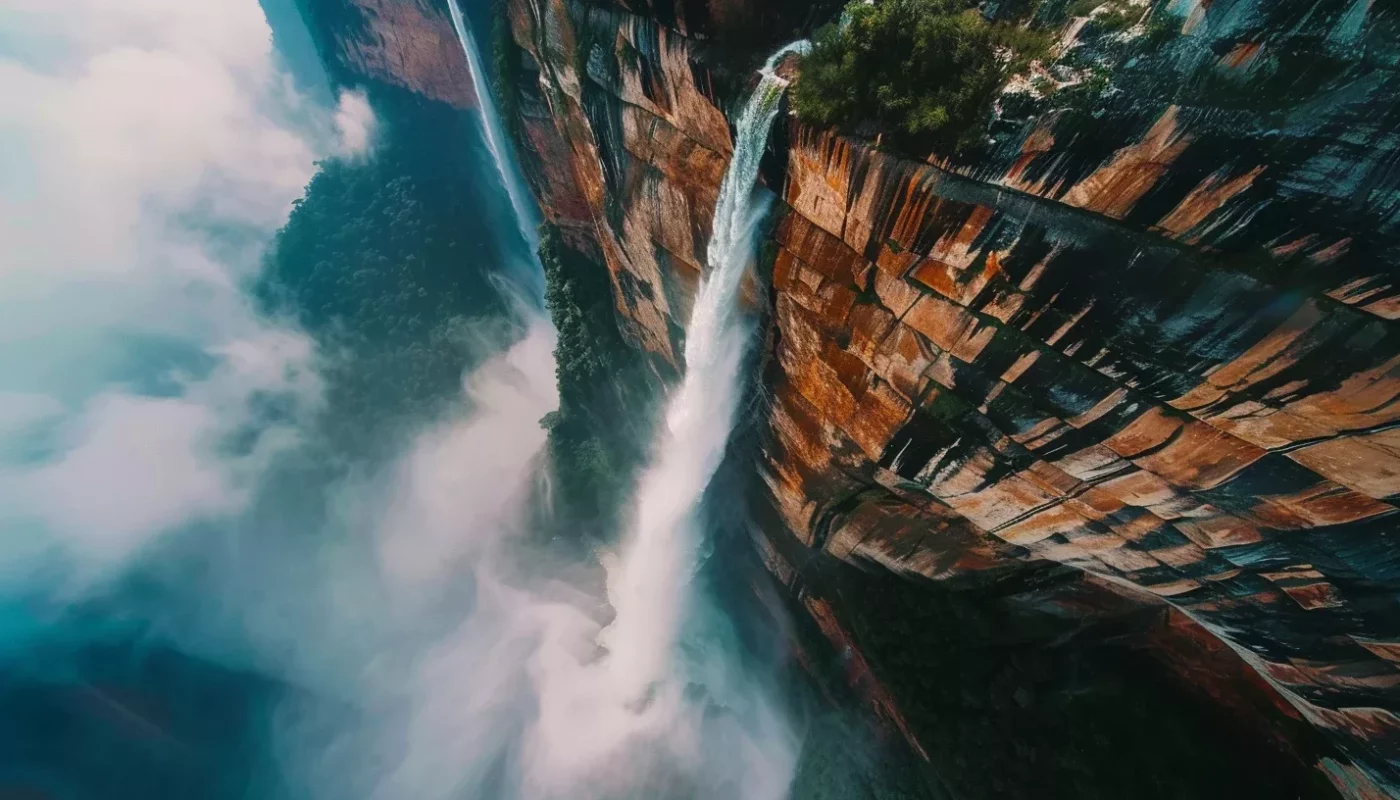Did you know Angel Falls is the tallest waterfall in the world? It falls from a height of 3,212 feet. This stunning natural sight is in Canaima National Park, Venezuela. It’s taller and more beautiful than any other waterfall on Earth.
Angel Falls is in the Gran Sabana region. This region is part of a UNESCO Heritage site. The waterfall’s dramatic drop includes a long plunge and smaller cascades. Then, there’s a final 98-foot drop. This makes Angel Falls a must-visit for nature lovers.
People come from all over to see Angel Falls. They want to experience its beauty firsthand. The waterfall’s height and the lush greenery around it make it a top sight in Canaima National Park.
Introduction to Angel Falls
Angel Falls is in Venezuela and is the world’s highest waterfall. It captures the hearts of everyone who sees it. The indigenous Pemon people call it Kerepakupai Vená, meaning “waterfall of the deepest place.” This name highlights its breathtaking beauty and importance.
This waterfall is deeply tied to Venezuela’s rich traditions. It shows the strong bond between nature and the indigenous people. For many, Angel Falls is more than a tall waterfall. It’s a symbol of natural wonder that attracts visitors worldwide. They come to witness its beauty and experience the vibrant South American culture.
The Geographical Location of Angel Falls
Angel Falls is one of the most stunning sights in the world. It’s found in Venezuela’s huge Gran Sabana region. The beauty of this natural masterpiece is realized through its setting.
Canaima National Park
Canaima National Park, which surrounds the falls, attracts nature lovers. It’s a UNESCO World Heritage site and is big, covering about 30,000 square kilometers. It’s one of Venezuela’s largest parks.
The park features special geological shapes, clean rivers, and dense rainforests. This mix offers a rich variety of life.
The Auyantepui Mountain
The majestic Auyantepui Mountain is another highlight. It stands tall, making Angel Falls’ incredible drop possible. This table-top mountain is an unforgettable view behind the falls.
Visiting this place in Canaima National Park reveals the stunning landscape. It shows why it’s considered a top sight worldwide.
| Feature | Description |
|---|---|
| Canaima National Park | Expansive park, UNESCO World Heritage site, diverse flora and fauna. |
| Auyantepui Mountain | Table-top mountain, source of Angel Falls, dramatic scenery. |
| Angel Falls | World’s tallest uninterrupted waterfall, iconic tourist attraction. |
The History Behind Angel Falls
The history of Angel Falls is full of intriguing stories and cultural importance. It’s the tallest waterfall without any breaks in the world. This fact has amazed both explorers and locals.
Discovery and Naming
An aviator named Jimmie Angel found Angel Falls in 1933. He was flying above the area, looking for valuable ore. Instead, he found the breathtaking waterfall. It was later named “Salto Ángel” to honor him.
This discovery added an exciting chapter to Angel Falls history. It made sure Jimmie Angel’s name would always be connected to this beautiful place.
Indigenous Names
Before the rest of the world knew about Angel Falls, the Pemon people called it “Parakupá Vená.” This means “the fall from the highest point” in Pemon language. The name shows how much the falls mean to their culture. It highlights the falls’ deep indigenous heritage.
<?p
Visiting Angel Falls: What to Expect
Planning a trip to Angel Falls? Get ready for some amazing adventures. You can choose from guided hikes through green landscapes or breathtaking aerial tours. Each option lets you enjoy the beauty of this natural wonder in its own way.

Tour Options
There are different tours for Angel Falls catering to all types of adventurers. Guided expeditions through Canaima tours bring you close to the falls. For a wider view, aerial tours show the full beauty of the falls from Auyantepui Mountain.
Best Time to Visit
The rainy season, from June to November, is the prime time to see Angel Falls. This is when the falls are full and stunning. Tours during this time let you see the falls in all their glory. Even in the dry season, Canaima tours are great, but the water flow is less.
| Tour Type | Highlights | Recommended Time |
|---|---|---|
| Guided Trek | Close-up views, intimate experience | June-November (rainy season) |
| Aerial Tour | Panoramic views, unique perspective | June-November (rainy season) |
The Unique Features of Angel Falls
Angel Falls stands out as the world’s highest plunge waterfall. It has an amazing drop of 3,212 feet. This makes a stunning view for those who visit. Located in the Canaima National Park, it’s not just about height. This place offers a journey into untouched nature, full of different plants and animals. The unique aspects of Angel Falls are not just its size. They invite travelers to see its unmatched beauty and rich ecosystem.
Angel Falls is in the vast Canaima National Park. The park is home to many kinds of plants and animals. Being a UNESCO World Heritage site, it highlights the beauty of the falls. The waterfall’s powerful drop is set against a green rainforest and special rocks. All these features together spotlight the unique aspects of Angel Falls. This place is perfect for those who love nature and seek adventure.
| Features | Description |
|---|---|
| Height | 3,212 feet |
| Location | Canaima National Park, Venezuela |
| Flora and Fauna | Diverse plant and animal species |
| Significance | Highest plunge waterfall, UNESCO World Heritage site |
The mix of the highest plunge waterfall with Canaima National Park‘s beauty is unforgettable. Each part, from the high waterfall to the living world around it, makes Angel Falls unique. It’s a wonder among the world’s waterfalls.
Explore Canaima National Park
In the heart of Venezuela, Canaima National Park is a wonderland. It’s not just about Angel Falls. This vast park reveals the beauty of South America. Visitors get to see its diverse life and many eye-catching spots.
Flora and Fauna
Delve into Canaima’s amazing plants and animals. It’s filled with different kinds of orchids and bromeliads. These plants make the park colorful. The park is home to animals like jaguars and giant anteaters. You’ll also see birds like the harpy eagle and scarlet macaw.
Other Attractions
There’s more to see than just plants and animals. Auyantepui Mountain is where Angel Falls starts. The park has peaceful lagoons and loud waterfalls like Sapo and Hacha. Plus, there are quiet rivers. Each spot shows the beauty of Canaima and South America’s nature.
How Angel Falls Compares to Other Waterfalls
When looking at the world’s tallest and highest waterfalls, Angel Falls is a standout. It reaches a stunning height of 3,212 feet. No other famous waterfall comes close, making it a breathtaking sight.
Compared to Niagara Falls and Victoria Falls, Angel Falls is unique. Niagara wows with its force, and Victoria with its wide veil. But Angel’s sheer drop puts it in a league of its own among natural wonders.
| Waterfall | Height (feet) | Type | Location |
|---|---|---|---|
| Angel Falls | 3,212 | Uninterrupted Plunge | Venezuela |
| Niagara Falls | 167 | Horseshoe | Canada/USA |
| Victoria Falls | 354 | Cascade | Zambia/Zimbabwe |
The Angel Falls comparison becomes even more evident with this table. It’s over six times taller than Victoria Falls and nearly nineteen times Niagara Falls’ height. Its lofty height and continual drop highlight its place among the world’s tallest and highest waterfalls. This makes Angel Falls a must-see natural wonder.
Preparing for Your Trip to Angel Falls
Planning a trip to Angel Falls? Remember, good preparation is key for a great experience. Below are some important Venezuela travel tips to think about:
- Research the Best Time to Visit: Visit Angel Falls from June to November to see it at its best. This is when the falls are truly stunning because there’s a lot of water.

- Understand Travel Logistics: Getting to Angel Falls is a journey. It usually starts with a plane ride to Canaima. Then, you’ll take a boat and hike to see the falls.
- Pack Appropriately: Pack light, quick-drying clothes and strong hiking boots. Also, bring a waterproof jacket and bug spray. And don’t forget your camera for amazing photos!
- Safety and Health Precautions: Carry your meds, water purifiers, and a first-aid kit. Also, think about getting shots for yellow fever and other diseases you might catch while traveling.
- Respect Local Culture: Meeting local communities is special. Learn from them and respect nature during your visit.
With careful planning, your visit to Angel Falls will be unforgettable. Embrace the stunning sights and make memories that will last.
The Significance of Angel Falls in South American Culture
Angel Falls, known locally as Salto Ángel, holds a deep cultural importance in South America. It stands out as a prominent Venezuelan landmark. Its towering presence and stunning beauty captivate many.
The legacy of Salto Ángel goes beyond its visual appeal. It is a key part of Indigenous history. The Pemon people, who are native to Venezuela, see it as a vital part of their culture. They express this in their myths and stories.
This waterfall is a symbol of Venezuelan pride. Its clear waters falling from Auyantepui Mountain represent a mix of beauty and history. This mixture secures its status in the heart of the country.
Angel Falls is important across South America, not just Venezuela. It is considered a valuable cultural asset. It is known for its stunning beauty and its role in the continent’s cultural and ecological stories.
Conclusion
Angel Falls is an amazing sight at 3,212 feet high. It’s located in Canaima National Park, Venezuela. The waterfall’s drop from Auyantepui Mountain is stunning.
It’s not just the tallest waterfall in the world. It also connects people to the power of nature and South America’s culture. Angel Falls is a symbol of Venezuela’s beauty. It shows how important it is to protect our natural wonders.
Visiting Angel Falls is an experience you won’t forget. You can explore it through guided tours or adventurous treks. This magnificent waterfall captures the essence of South America’s landscapes and cultures.




